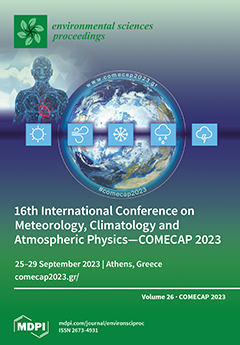Carbon monoxide, XCO, and methane, XCH
4, column-averaged dry-air mole fractions (DMFs), observed by the TROPOspheric Monitoring Instrument (TROPOMI) on board Sentinel-5P (S-5P), are validated against those obtained from a Bruker ground-based low-resolution Fourier transform spectrometer, EM27/SUN, operating in the framework and
[...] Read more.
Carbon monoxide, XCO, and methane, XCH
4, column-averaged dry-air mole fractions (DMFs), observed by the TROPOspheric Monitoring Instrument (TROPOMI) on board Sentinel-5P (S-5P), are validated against those obtained from a Bruker ground-based low-resolution Fourier transform spectrometer, EM27/SUN, operating in the framework and according to requirements of the Collaborative Carbon Column Observing Network (COCCON), in Thessaloniki, Greece, on a mid-latitude urban site. The current operational S5P/TROPOMI observations show very good agreement with the respective FTIR measurements and capture both their seasonal variability and pollution episodes. XCO reported the highest concentrations during the fire episodes in summer 2021, when its daily mean value reached a maximum of 0.134 ± 0.015 ppm. XCH
4 shows a slight annual increase of 0.02 ppm, with the highest concentrations during early 2022 (approximately 1.92 ppm). The satellite CH
4 and CO products have been recently reprocessed with updated CH
4, CO and H
2O cross-sections, among other improvements, bringing noticeable changes in the pre-existing biases of S5P products against the FTIR ground-based data. We report that, for this mid-latitude station, mean biases and standard deviations fall well within mission requirements for XCH
4 and XCO (−0.01 ± 0.6% and 0.62 ± 4.2% for XCH
4 and XCO, respectively), underlying the significance of satellite measurements as a valuable supplement to ground-based data for the purpose of greenhouse gas monitoring. The results presented in this work for the Thessaloniki FTIR instrument are in strong agreement with FTIR locations in the middle latitudes.
Full article



